12.4 Karst Cave Features, Cave Contents, and Subterranean Life
Karst caves are caves that are primarily formed through solutional processes and most are hosted in carbonate bedrock. The size definition for a cave is somewhat subjective, but it generally includes anything enterable by a human. Openings smaller than this are referred to as fissures, conduits or proto-caves. Karst caves make up most of the caves worldwide, but caves can also be formed by other processes and environments, such as:
- Lava tube caves found in basalt flows (Figure 12.4.1),
- Ice caves in glaciers,
- Crevice (or tectonic) caves found along geological faults or folds or formed by mass movement or gravity,
- Erosional caves formed in softer rocks eroded by water or wind,
- Littoral or sea caves caused by wave action,
- Talus caves under piled rock debris (Figure 12.4.2), and
- Piping caves formed in unconsolidated materials by the removal of fines by water flow.
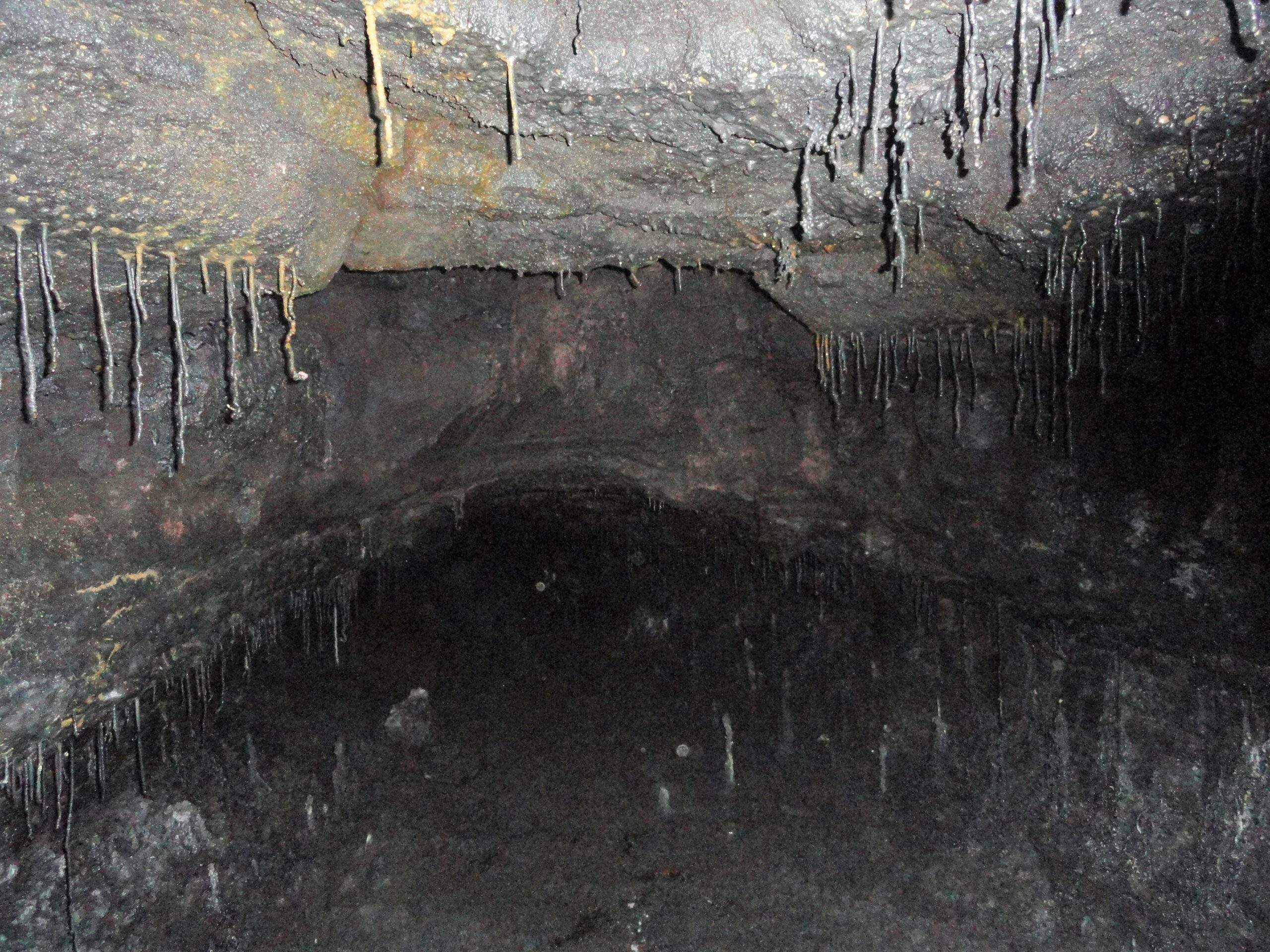
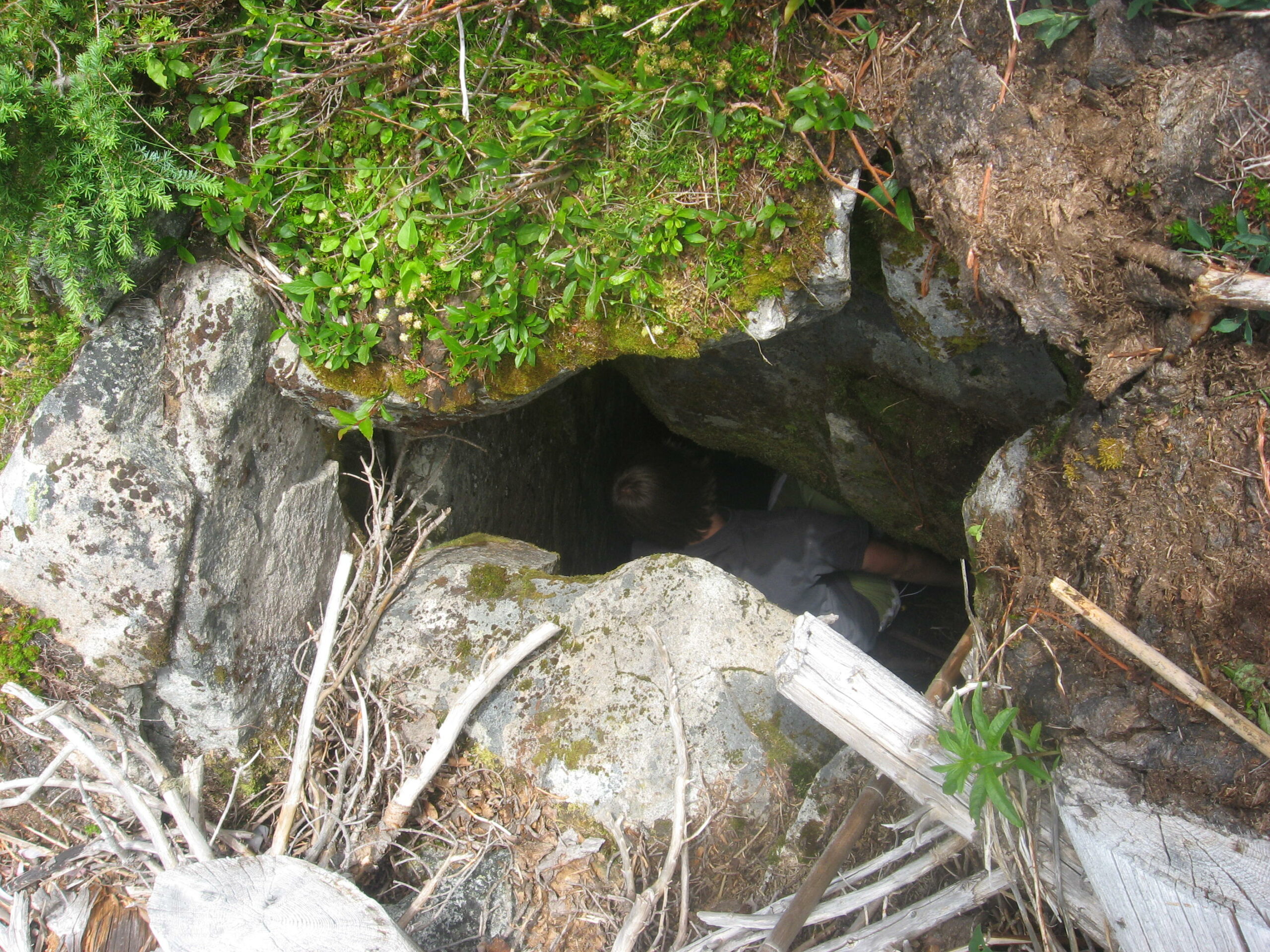
Karst caves may appear as complex or random forms when displayed in maps or cross-sections. However, caves are typically comprised of three fundamental components: passages, chambers, and cave entrances. These components can occur in a whole range of different combinations and permutations. A cave passage can be considered as an elongated element, with a length dimension greater than its height or width. Passages can be horizontal, inclined, or vertical – a vertical passage is usually termed a pitch or pit (Figure 12.4.3). Passages can also be linear (straight), angular, or sinuous:
- Linear passages typically occur along the strike of the limestone beds,
- Angular passages can indicate fracture control by joints, and
- Sinuous passages can be found in flat or gently dipping limestone beds with less fracture control.
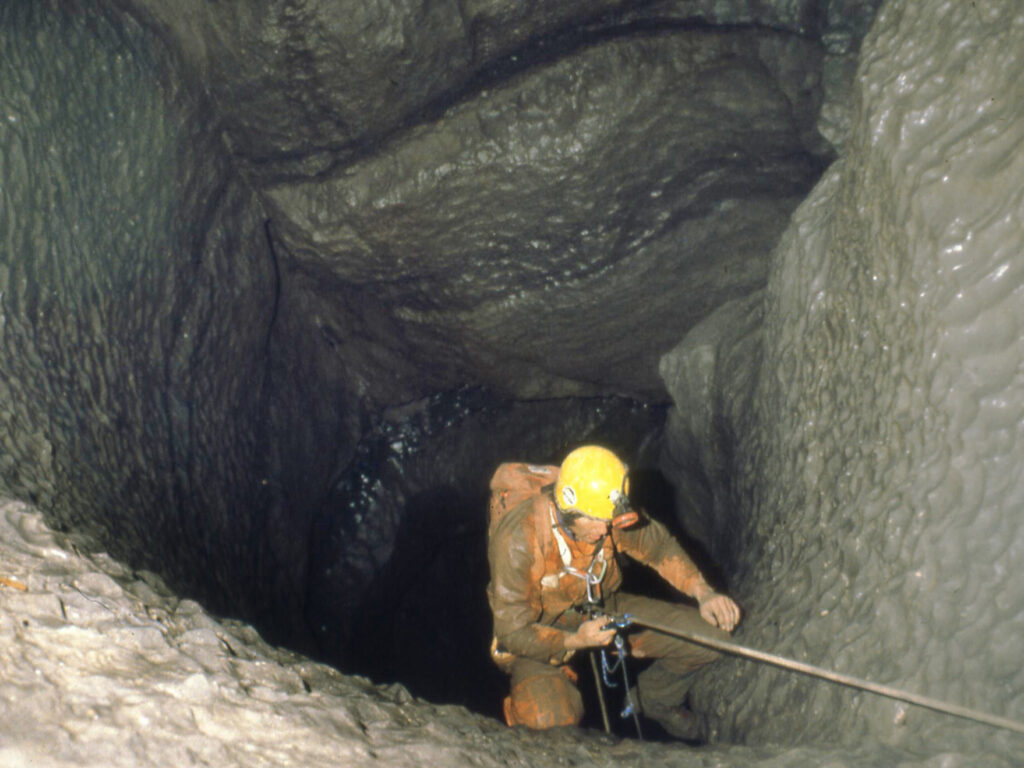
The shape or profile of passages tells us a lot about how the cave formed. Circular, elliptical, or tube-like passages have likely been formed under water-filled (or phreatic) conditions below the water table. More irregular passage profiles are formed above the water table by streams with air space above (vadose conditions). In many cases, passages display evidence of earlier phreatic (aerated) phases overprinted by subsequent vadose (flooded) ones. A great example of this is a keyhole passage – where a phreatic tube has been incised by a vadose channel. Other major constraints on passage shape are:
- The orientation of bedding planes and joints,
- The infilling of the passage with introduced sediments, and
- Cave breakdown material.
Chambers, or rooms, are localized sites of cave passage enlargement where there is a significant increase in height or width of the passage. Chambers may form due to the intersection of two or more passages or where preferential erosion has occurred; e.g., extensive breakdown of the ceiling (Figure 12.4.4). One of the largest chambers known is at Mulu Caves in Sarawak (Borneo), where there is a 700 m long, 400 m wide and > 70 m high chamber. Chambers can also form by the upwelling of hydrothermal solutions.
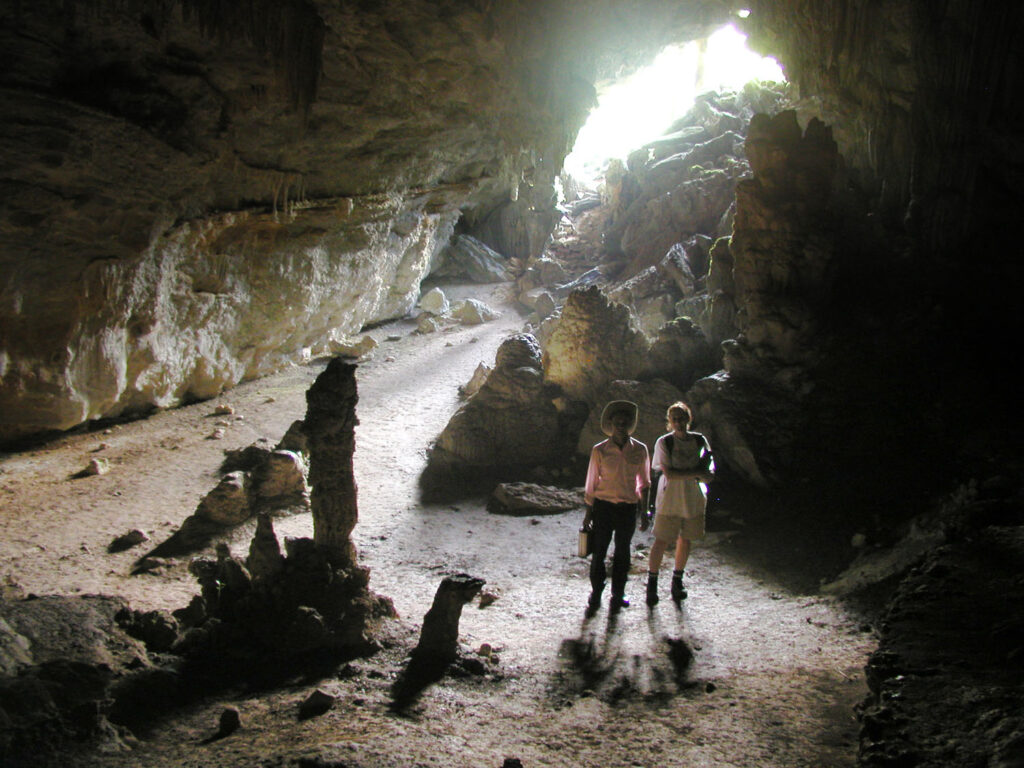
All caves that are entered by humans have openings or entrances unless a man-made opening has been made into a cave. Cave entrances do not necessarily play a significant role in cave development unless they capture a sinking or discharge a rising stream. Caves can quite easily develop without enterable entrances, and entrances may form later in the life of a cave as the overlying landscape is eroded and openings (or windows) into underlying caves occur. Individual caves in any given area may be hydrologically linked to other nearby caves forming a network of passages, chambers, and conduits. These caves then become part of what is known as a cave system.
Cave Speleogens and Speleothems
Speleogens are the rocky relief features in caves while speleothems are the mineral formations present in caves. Mineral formations differ from cave sediments in that they only form inside the caves, while cave sediments from materials inside caves (autochonous) and also from materials bought from the outside to the inside of caves (allochthonous).
Speleogens as rocky relief features are centimetre to metre-scale and are found on the interior surfaces of caves and are the result of chemical dissolution, mechanical erosion, or a combination of both; and are useful in interpreting the cave’s history and genesis. Speleogens can include:
- Linear grooves or flutes on steep surfaces,
- Canyons and incised meanders,
- Recessions and depressions on the passage floor, ceiling, or sidewall walls of caves forming scallops, potholes and spongework,
- Horizontal slots on side walls including notches or bevels (Figure 12.4.5), and
- Protuberances in cave passages, such as pendants, knife edges, spikes, and pillars.
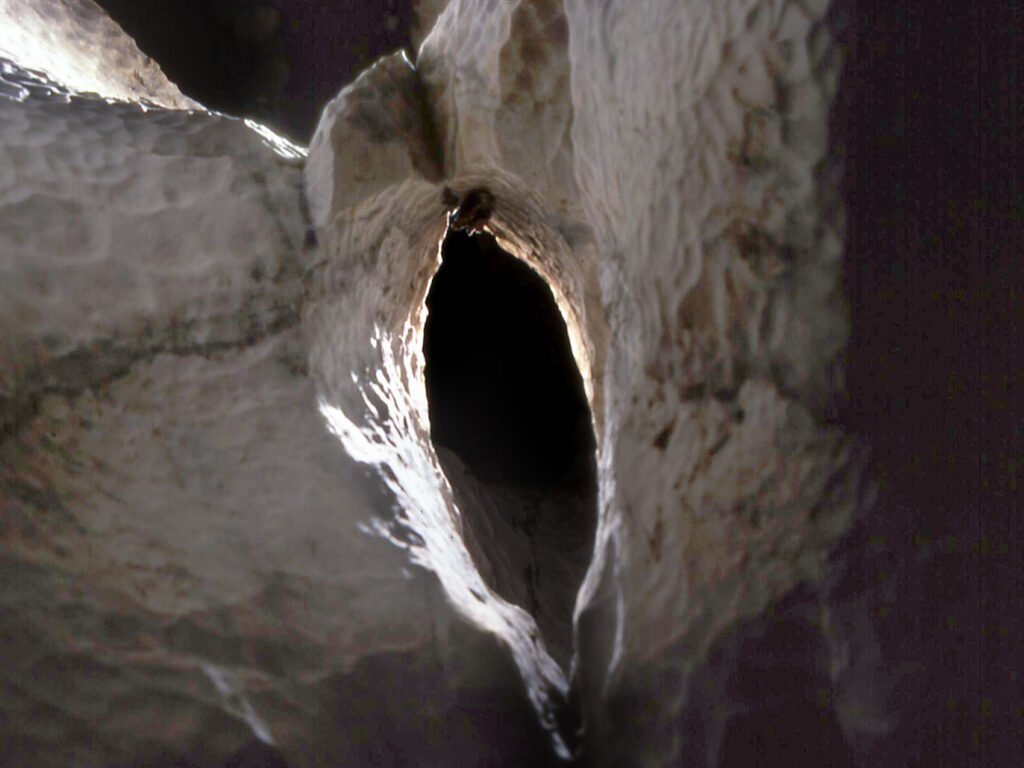
Scallops are spoon-shaped hollows are formed by eddies in water flow and vary from a centimetre to a metre in size and have a distinct asymmetry (Figure 12.4.6). The steeper side indicates the upstream direction of paleoflow. The size of the scallops can also tell us something about the speed of the flow – the smaller the scallop the greater the flow. Potholes are circular basins centimetres to a metre in diameter that occur along stream beds in cave passages. Potholes develop where there is rapid water flow combined with rock fragments that grind into the bedrock in a swirling motion. Spongework are where random holes or cavities are present on the walls or ceiling of the cave and develop under phreatic conditions in slow moving and swirling water flow.
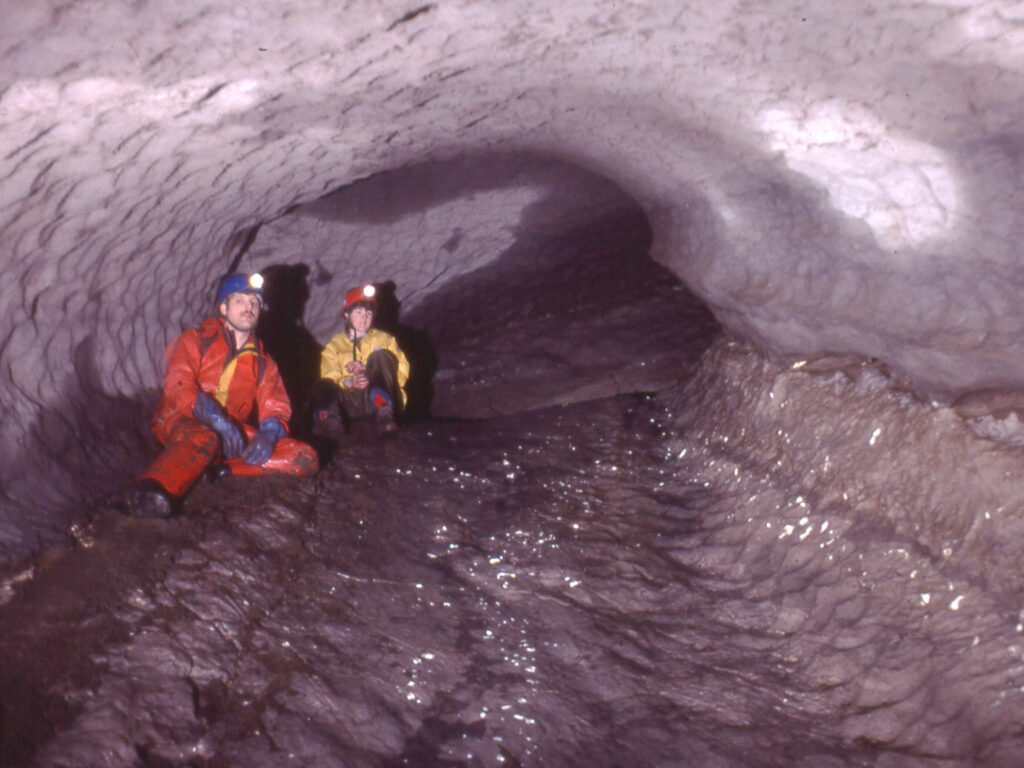
Speleothems are cave mineral formations or decorations (Figure 12.4.7). Stalactites (which are attached to ceilings and ledges and grow downward) and stalagmites (which grow upward from the cave floor) are probably the best-known examples of cave decorations. Many other kinds of speleothems have been identified and vary widely in size, form, and chemical composition. Despite this, they all have one thing in common – they are all secondary compounds that have either: been formed because of some chemical interaction with cave substrates or have been precipitated out of karst system waters under subterranean conditions. Given limestone’s chemical composition, the most prevalent cave minerals are forms of calcium carbonate. The arrangement of atoms within calcium carbonate can combine in three ways, producing three minerals: calcite, aragonite, or vaterite. These minerals (also called polymorphs) are identical in terms of their chemical composition, but differ in terms of their crystalline structure, and stability. Most calcite formations are colourless or white, but the presence of certain impurities, or chromophores, can have impart on the various colours or degrees of opacity to speleothems (e.g., brownish yellow associated with iron oxide).
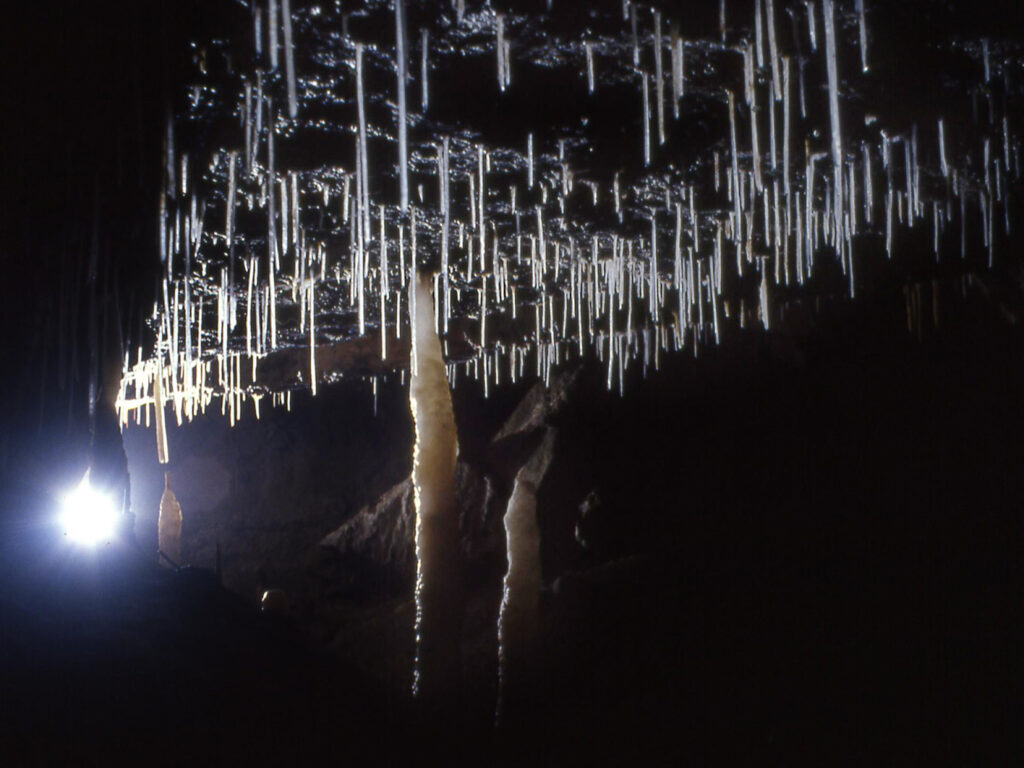
Speleothems form when the calcium carbonate-saturated water emerges into underground opening or caves and meets air. Under these conditions carbon dioxide is released from the water into the cave atmosphere, reducing the carbonic acid level of the water, and calcium carbonate will begin to precipitate out of the water. Calcium carbonate is only readily soluble in pure water if the water is acidic. As the carbon dioxide level of the water decreases, the acidity will also decrease along with the solubility of calcium carbonate. In drier caves evaporation might also play a role leaving behind deposits of calcium carbonate in the form of calcite or aragonite. There are also other ways for the carbon dioxide content of water to be diminished and for calcite to be deposit, such as by increasing the temperature of the water (lessening the solubility of the carbon dioxide) and by the actions of certain bacteria.
Cave mineral formations can be grouped under three broad categories: dripstone and flowstone forms, erratic forms, and sub-aqueous forms. Dripstone and flowstones include the types of formations most people are familiar with and typically associate with caves including stalactites, stalagmites, flowstone, draperies, and columns (Figure 12.4.8). These formations can take an astonishing variety of sizes, shapes, and forms. The other two categories represent formations that may be less familiar. Erratic forms include shields, helectites, botryoidal forms, anthodites and moonmilk. While sub-aqueous forms include rimstone pools, concretions, pool deposits and crystal linings (Figure 12.4.9).
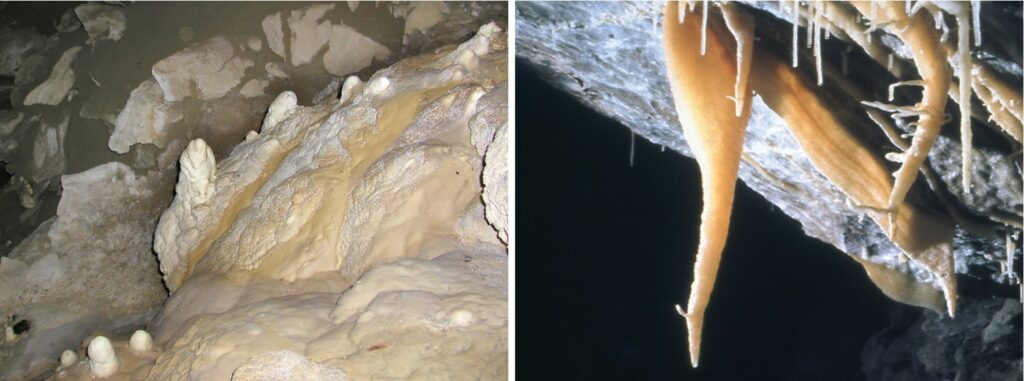
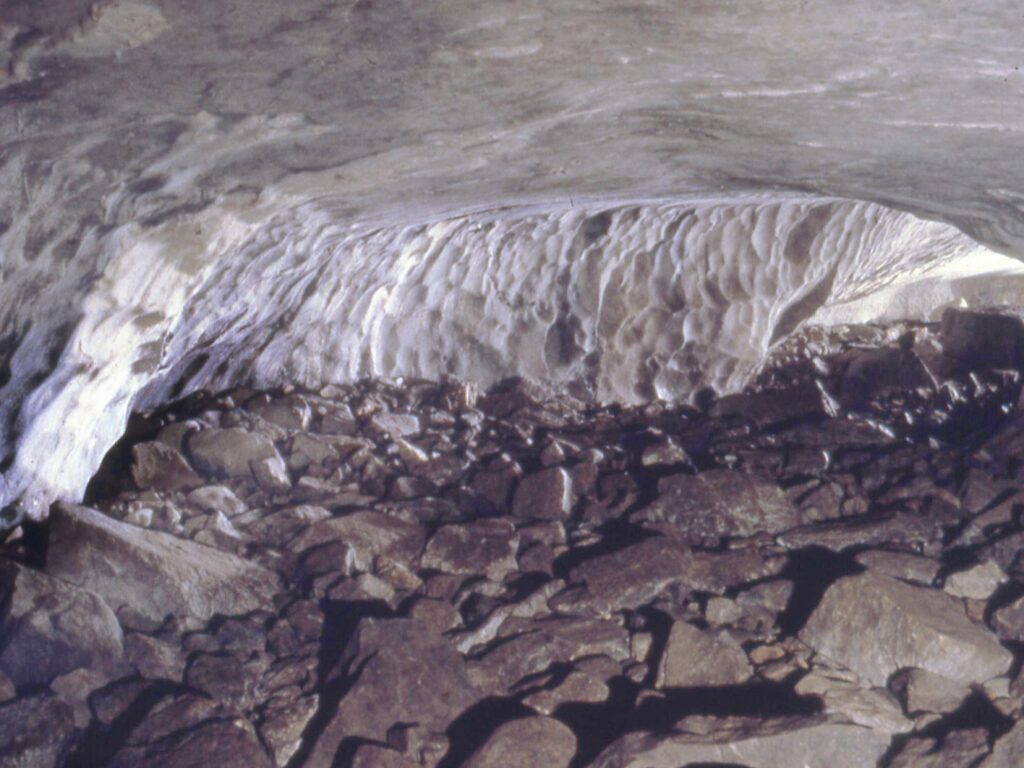
It is very important to understand that speleothems are not just static and ‘pretty’ formations; they are dynamic structures, resulting from natural processes operating in the underground environment and in the broader karst system. If these processes are interrupted or altered, speleothems may be affected, sometimes with unfortunate consequences. Remember too that the calcite deposition process is reversible, and that these formations can be re-dissolved if they are exposed to water that is slightly acidic.
The rate of speleothem growth is quite variable and is based on many factors, including: climatic conditions on the surface and underground, groundwater flow rates and characteristics, drip-water composition, microbial activity, size and nature of underground openings, and carbon dioxide concentrations. If the amount of water percolating down through the soil is reduced, due to arid or extremely cold conditions on the surface, calcite deposition may slow down or stop altogether. Calcite deposition rates tend to be greatest in environments that are continually warm and wet. Different types of speleothems grow at different rates. Soda straws and entrance zone speleothems (where evaporation is greater) often grow much more rapidly than more solid forms like stalactites and flowstone. Soda straw growth rates have been measured at between 0.2 mm and 20 mm per year, as opposed to rates of <0.005 mm to 0.7 mm for stalagmites .
Speleothems can contain information about past environmental conditions, and several techniques have been developed to access this information. Analyses of the stable isotopes of 16O and 18O in speleothems can provide records of cave temperatures which are generally quite stable, hovering somewhere around the annual mean surface temperature year-round. Over long periods, warming and cooling trends in caves therefore reflect general surface trends in temperature. Analyses of 13C to 12C ratios in speleothems have been utilized as proxy indicators of changes in surface vegetation cover in the catchment. Non-isotopic studies on speleothems have focused on the analyses of various impurities or detrital inclusions in speleothems including pollen, volcanic ash, fine clay particles and smoke particles embedded in layers of calcite. Since speleothem layers can sometimes be dated, it is possible to make inferences about vegetation cover, volcanic activity, and fire regimens at various times of the cave’s history.
Exercise 12.3 Deposition of Calcium Carbonate

Figure 12.4.10 shows a drop of water that has seeped out of a hollow speleothem within a limestone cave.
- What type of speleothem is this?
- From each such drop of water a tiny amount of calcium-carbonate is deposited at the tip of the speleothem. What is happening within the drop of water to allow that deposition to take place?
- When the drop is released, it will fall to the floor of the cave and likely contribute to the buildup of a speleothem there. Why?
- What type of speleothem will form there?
Exercise answers are provided Appendix 2
Cave Sediments
Cave sediments typically refer to accumulations of unconsolidated material that is of inorganic or organic origin in a cave. Since caves are negative relief features in the landscape (i.e., they are holes as opposed to hills), they often act as sediment traps. Sediments can originate either outside or inside a cave, and they can be comprised of loose rocky material, organic matter (plant and/or animal), minerals, or some combination of these constituents. The mineral or chemical composition of the sediment can sometimes indicate its origins. As in surface environments, particle sizes of cave sediments can range dramatically from very fine silts and clays to huge boulders. All provide clues as to how the material was transported and deposited into a particular underground locality: the particle sizes, degree of sorting (i.e., the extent to which particles or clasts are of uniform size), and patterns of sorting present in a sediment layer.
The simplest way of first classifying cave sediments is to determine whether the sediments originated inside or outside the cave. Allochthonous (or allogenic) sediments come from sources outside of the cave system and are subsequently transported underground by a variety of mechanisms such as gravity, water, wind, or animal activities (Figure 12.4.11). Autochthonous (or authigenic) sediments originate within the cave system itself. Allochthonous and autochthonous sediments can further be broken down into three sub-categories that describe their material types: clastic sediments, organic sediments, and precipitates/evaporates. Clastic sediments are the products of the mechanical breakdown of rocks. The individual particles resulting from this process are called clasts. Clastic sediments in caves can be either: allochthonous or autochthonous. A typical example of autochthonous clastic cave sediment would be large angular blocks of rock that have fallen from the cave ceiling – these are generally referred to as “breakdown”. Breakdown is often easy to identify because it is comprised of the same host bedrock as the cave and is often quite large and blocky. It is not uncommon to see breakdown blocks the size of trucks and every caver hopes not to be present in a cave when breakdown occurs. Other autochthonous cave sediments owe their origins to less dramatic events. For example, some limestone contains nodules of insoluble materials like chert. As the limestone containing these nodules dissolves around them, they are released from the bedrock and become autochthonous sediments in the cave.
Allochthonous clastic cave sediments originate in the cave’s catchment and are transported into the cave system by water, gravity, and wind (Figure 12.4.11). Caves that were once at or below sea level may contain marine deposits carried in by wave action and tides. Allochthonous organic sediments may enter cave systems by these means as well but can also be transported in by living organisms such as bats, birds, denning animals, and humans. Human occupation of caves over long periods of time can result in surprisingly deep culturally derived sediment deposits, but these archaeologically significant deposits are usually confined to cave entrance zones which offer more favourable habitation sites than areas deeper within the caves. The activities of other animals such as bears, or bats can contribute to organic sediments in areas well beyond the entrance zones. Some of the clays and sands present in caves are produced this way.
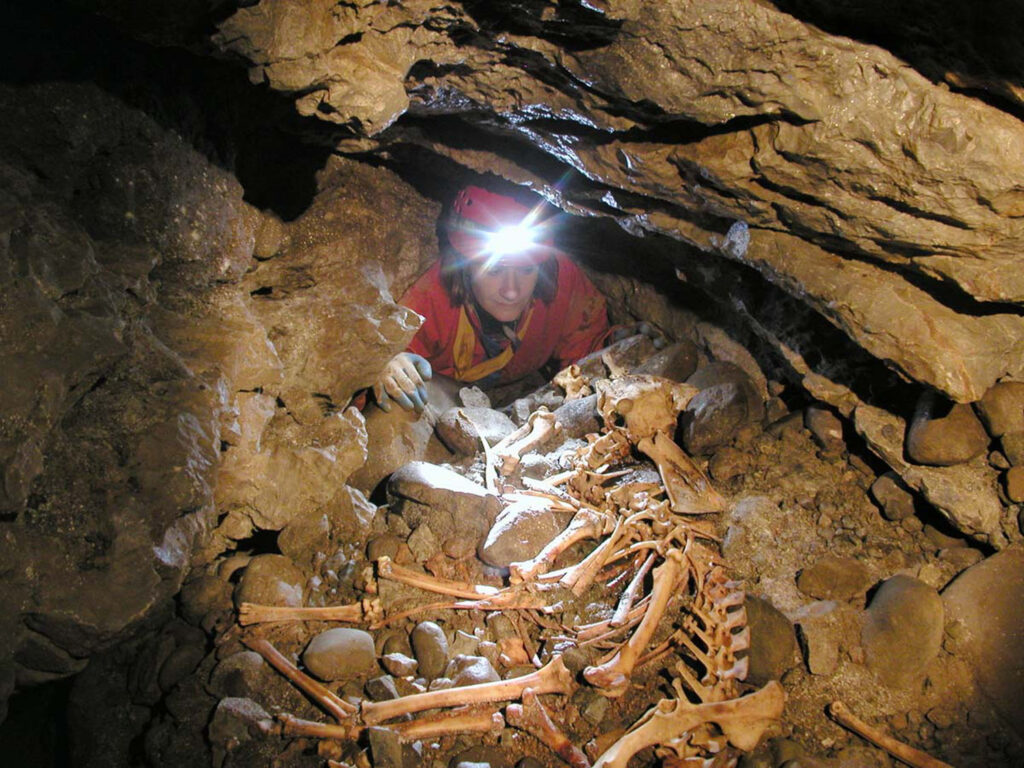
Accurate interpretation of cave sediments requires familiarity with both cave processes and the principles of sedimentology, as well as access to appropriate dating techniques. The study of cave sediments can potentially yield information about events in a cave’s history but interpreting them is not always a straightforward task. Of course, this does not mean that reworked or redeposited sediments are useless or without value, as they can always tell us something about energy regimes, transport mechanisms and depositional environments within the cave. The trick is really to understand the limitations of what cave sediments can reveal and to ask the appropriate questions, based on those constraints.
Subterranean Life
At first glance, caves seem rather barren places, and inhospitable to life. In the constant darkness underground photosynthesis cannot take place, so the primary producers of surface ecosystems – living photosynthetic plants – are almost completely absent. In cave environments, the base of the food web starts with fungi and bacteria. Plant material in the form of detritus and other organic debris is transferred into caves by water, gravity, air currents and is broken down by these organisms. Animal carcasses – especially those of bats – can also be an important source of nutrients, as is bat guano. In some caves the “food delivery system” may be erratic, but even when this is not the case, productivity in cave ecosystems tends to be quite low compared with surface ecosystems.
Not all cave ecosystems are based on organic substances transported in from the surface, however. In some caves – Mexico’s Cueva de Villa Luz, for example – inorganic substances like hydrogen sulfide provide the energy source for sulfur eating bacteria, which are then consumed by other organisms in the food web. Larger protozoans, beetles, snails, nematodes, flatworms, springtails, and millipedes can all function as detritovores (i.e., organisms which feed directly on organic detritus) in cave ecosystems. While smaller organisms may act as microbivores by feeding on the bacterial and fungal hyphae. These in turn may be preyed upon by fish, spiders, crustaceans, centipedes, beetles and other larger vertebrates and invertebrates in the cave (Figure 12.4.12). Some of the larger vertebrates found in caves include salamanders and bats. In cave ecosystems, species richness (or the range of different species) may be quite high, but the overall number of organisms supported may be low as compared to surface ecosystems of a similar size.
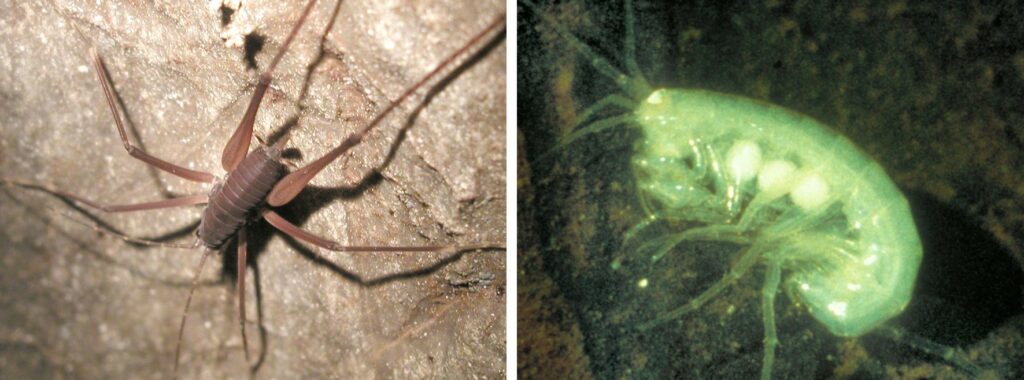
In cave-adapted organisms, eyes are often rudimentary structures, or totally absent. By contrast, their other sensory organs may be highly specialized and enlarged. They tend to lack pigmentation, and their appendages (if they have any) may be modified to give them better purchase on rocky wall and floors. They may have different cycles of activity than those of surface dwellers. Finally, they tend to be small, and have lower metabolic rates. Remember, photosynthesis cannot occur in caves, so the food web is mostly based on meager supplies of available nutrients (perhaps in the form of organic detritus or guano) transported into the cave, either by water, gravity, air currents, or other animals. In any case, productivity is relatively low – so there are advantages to being small, fuel efficient, and not too prolific.
Subterranean life forms are classified according to how dependent they are on the underground environment. Troglobites are cave-adapted organisms that cannot survive on the surface and must spend their entire lives in caves. Troglophiles are creatures that can spend their entire lives in caves, but that also occur in similar dark, damp surface environments. These include species of spiders, crickets, and salamanders. Trogloxenes are organisms that use caves for some portion of their life cycle, but that also spend part of their time on the surface including bats and harvestman, both of which forage outside of caves. Accidentals are creatures have no special affinity for caves; instead, they have either wandered in under their own power or ended up there by accident – by falling down a shaft, say, or being washed in. Extremophiles are not necessarily cave-dwelling organisms and refers to organisms that have adapted to conditions such as temperature, pH, or the mixture of atmospheric gasses that fall outside what we humans consider to be outside the normal range. Extremophiles are microbes that have been found living in or around extreme environments such as undersea hot vents but can also occur in some caves.
Media Attributions
- Figure 12.4.1 Photo by T. Stokes, CC BY 4.0
- Figure 12.4.2 Photo by Steven Earle, CC BY 4.0
- Figure 12.4.3 Photo by P. Griffiths, CC BY 4.0
- Figure 12.4.4 Photo by P. Griffiths, CC BY 4.0
- Figure 12.4.5 Photo by P. Griffiths, CC BY 4.0
- Figure 12.4.6 Photo by P. Griffiths, CC BY 4.0
- Figure 12.4.7 Photo by P. Griffiths, CC BY 4.0
- Figure 12.4.8 Photos by P. Griffiths, CC BY 4.0
- Figure 12.4.9 Photo by T. Stokes, CC BY 4.0
- Figure 12.4.10 Photo is Public domain from Piqsels.com, https://www.piqsels.com/en/public-domain-photo-zibbt/
- Figure 12.4.11 Photo by P. Griffiths, CC BY 4.0
- Figure 12.4.12 Photos by P. Griffiths, CC BY 4.0
